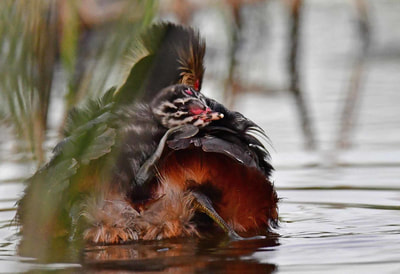 We enjoyed a magical few hours in late June at Frank Lake, a very rich wetland located just east of High River. The lake has a boardwalk and viewing area, making it very accessible for bird watchers and photographers. We arrived in the evening, just as the setting sun bathed the lake in a warm red glow. Much to our surprise and delight, a pair of Eared Grebes with two young were feeding in the shallows within a metre of the boardwalk. They were very tame, so we were treated to a wonderful wildlife viewing experience. We returned the next morning, which was even more interesting because another adult grebe with a larger baby was also feeding. It was a photographer’s dream to be able to capture these fascinating little birds going about their daily routines. Eared Grebes are small water birds that nest in shallow lakes across Central Alberta. Once a pair has bonded (a process entailing elaborate courtship activities, which I have yet to see), they work together to construct sodden nests by heaping vegetation into a floating mound that is attached to cattails or other aquatic vegetation. Interestingly, incubation starts with the first egg, so the young hatch at different times. Like all waterfowl, baby grebes are able to swim after they hatch. However, since they are not yet waterproof and cannot feed themselves, they spend the first few days of their life being brooded on their parents’ backs. They enter the water to defecate and splash around before clambering back on. Each parent takes turns carrying the young on their back while the free parent hunts for small aquatic invertebrates to bring back to the “mother ship.” As the young age, the parents will encourage them to become independent by rising up in the water and flipping them off their backs. Once the young are about 10 days old, the parents divide the brood (usually only 2) and then cease parental care when the young reach 20 days of age. Young grebes are garishly colored, with black and white stripes and bold pink blotches of skin on their forehead and around their eyes. The adults are beautifully attired, with a yellow upsweep of feathers and piercing red eyes. With legs attached at the backs of their bodies, they are expert divers. Unlike most waterfowl, they have lobed, not webbed, feet. I highly recommend a trip to Frank Lake to see these and other interesting bird species. Leave a Reply. |
AuthorMyrna Pearman Archives
August 2022
|
All photos and published works on this website are copyright Myrna Pearman unless otherwise noted.
Re-posting these images or publishing is not permitted without Myrna's written consent.
Copyright Myrna Pearman Publishing 2024- Site design and maintenance by Carolyn Sandstrom
Re-posting these images or publishing is not permitted without Myrna's written consent.
Copyright Myrna Pearman Publishing 2024- Site design and maintenance by Carolyn Sandstrom







 RSS Feed
RSS Feed



15/7/2018
0 Comments